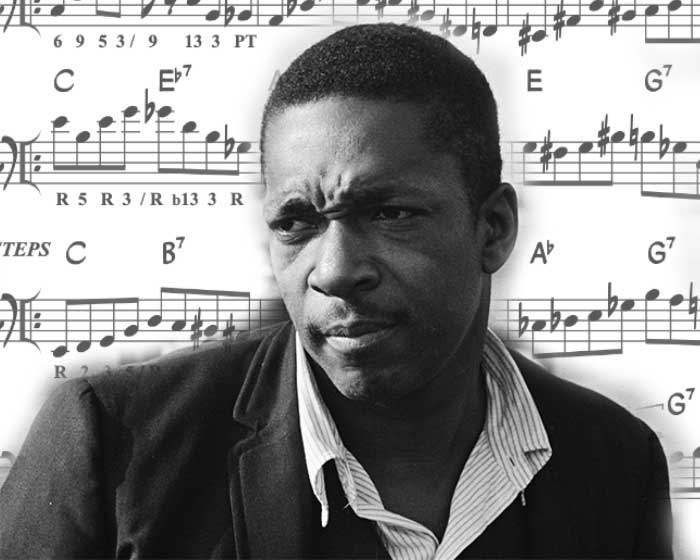Exercises and Sequences for Overcoming Fear of “Coltrane Changes” Once and For All

As 2019 marked the 60th anniversary of John Coltrane’s initial recording of “Giant Steps” (March, 1959 for the Atlantic record label), it seems hard to believe that it was really that long ago. Along with an additional pair of originals, “Countdown” and “Fifth House”, also recorded that year, these three tunes employed a harmonic device described technically as “The Cycle of Descending Major 3rds”, which soon became recognized throughout the known universe as “Coltrane Changes”.
In late October of the following year, fronting his recently formed quartet (which featured co-innovators – pianist, McCoy Tyner and drummer, Elvin Jones ), ‘Trane recorded “Satellite” (based on “How High the Moon”), “26-2” (based on Charlie Parker’s “Confirmation”), among others – bringing the total to nine Coltrane originals which used, in whole or in part, the “Cycle of Descending Major 3rds”.
Coltrane’s fondness for this harmonic device as a basis for his compositions and improvisations did not last much longer than these recording sessions, however. Instead, he superimposed this, and other harmonic cycles and devices, into the modal and polymodal music which he embraced until his passing at the much too early age of 40, in July of 1967.
“Coltrane Changes” remains one of ‘Trane’s numerous legacies. Subsequent generations of improvising musicians (meaning “us”) have been tasked with the challenge that “Giant Steps”, “Countdown” and “Satellite”, etc. all pose – if for no other reason than as a rite of passage. As a musical device, however, the Major 3rds Cycle continues to have its own musical applications.
Coltrane’s original intention with this cycle was as a substitution for the common ii-V7-I cadence, which made up virtually every popular and Jazz standard of the era. While on tour in Europe with Miles Davis in March & April, 1960 (his last with the trumpeter), Coltrane told Swedish radio interviewer Carl-Erik Lundgren, “…there are some harmonic devices that I know…, that will take me out of the ordinary path…”. One of those devices he was referring to was certainly the Maj 3rds Cycle.

A common misconception in the description and teaching of Coltrane’s Descending Cycle of Maj 3rds has been that it’s “up a minor 3rd, down a Perfect 5th”. While this accurately describes the root movement, the recognition of the Maj 3rds Cycle as a symmetric harmonic entity is not properly taken into account.
The Cycle of Descending Maj 3rds is just that: Three Major tonal centers (triads, 6 or Maj7 chords) – in descending order – a Maj 3rd apart (C-Ab-E), preceded by each of their Dominant 7ths (Eb7-B7-G7 – back to C). In other words, this cycle divides the octave into 3 equidistant key centers, requiring the improviser to command all three. Therein lies the challenge – running a single Major or minor scale through the changes won’t cover it (although the hexatonic Augmented Scale, based on 2 mutually exclusive augmented triads, creates some interesting possibilities – see Ex. 5).
One method employed by ‘Trane in his recordings as a means of meeting this demanding scenario and negotiating the rapid tempi of “Giant Steps”, “Countdown”, “Satellite”, etc. was his use of 4-note scale fragments, known as “digital patterns” (digital referring to the fingers, rather than the technology). Besides facilitating the perceived harmonic obstacle course that these tunes pose, digital patterns also help to outline the rapidly changing tonal centers in an easier-to-execute fashion.
Ex. 1 – Cycle of Descending Maj 3rds
The example below illustrates an ascending sequence with a pair of 4-note, diatonic “digital patterns” per measure. The V7-I movements (Eb7-Ab, B7-E & G7-C) are each expressed with a single ascending scale. The numbers under each 4-note grouping in the first measure indicate the note’s position relative to that chord’s root (R).

Ex. 2 – Cycle of Descending Maj 3rds
The next example shows a repeating descending sequence. The finger friendly diatonic digital patterns connect melodically to each new tonal center (C-Eb7, etc.) by the interval of an Augmented 2nd (min 3rd); resolving from each V7 to I (Eb7-Ab, etc.) by a half step.

Ex. 3 – Cycle of Descending Maj 3rds
Another descending sequence with the first note of each 4-note grouping (C-Bb-Ab-F#-E-D-C) descending in whole steps. Rests and triplets are used to give the line some rhythmic variety and avoid the monotony of continuous eighth notes.

Ex. 4 – Cycle of Descending Maj 3rds
Unlike the previous examples, this one is a non-parallel sequence, featuring an intervallic melodic approach. It implies Pentatonic as well as clear 027 Trichord usage.

Ex. 5 – Cycle of Descending Maj 3rds
This is a sequence consisting exclusively of melodic material derived from a single C (E &/ or Ab) Augmented Scale. Like the Maj 3rds Cycle itself, it divides the octave into three equal parts, as does the Augmented Triad. Depending on how much dissonance is acceptable in each case, care should be taken with note selection in expressing both Major and Dominant harmonies. In this example, a Major plus an Augmented Triad (Dom7 b13) in each measure, present a consonant, “safe” bet.

“Retrosteps” and The Cycle of Ascending Major 3rds
The Cycle of Ascending Major 3rds, which I’ve taken the liberty of naming “Retrosteps” (as in “backwards Giant Steps”), is a result of my curiosity as to “how and if” changing the direction (and thereby the order) of the ‘descending 3rds cycle” might work out.
As it turns out, it works out pretty well, although there isn’t a radical shift in overall sonic impact since, after all, it’s still a Major 3rds cycle. The perceived difference is subtle, but apparent.

As is shown above, the real difference here is not so much a harmonic change in direction as it is a switch in the order between the V7-I resolutions across bars #1 – 2 (Eb7-Ab) and #2 – 3 (B7-E).
The root movement goes from “up a minor 3rd, down a Perfect 5th” in “Coltrane Changes” to “down a half step, up a Perfect 4th” in “Retrosteps”.
It should be noted that the middle part of “Giant Steps” (bars #9-13) is actually comprised of an ascending cycle – 3 ascending Major tonalities, each preceded by its ii-V7, lasting a bar apiece:

Ex. 6 – Cycle of Ascending Maj 3rds
Starting with the same basic R-2-3-5 digital pattern (in C Maj) as Ex. 1, the difference here is the connection point to B7 – as opposed to Eb7 in the Descending Cycle.

Ex. 7 – Cycle of Ascending Maj 3rds
This sequenced line combines arpeggiated Maj triads with b7-R-9(2)-3 digital patterns on the Dom 7 chords (as in Ex 1). Rests and triplets are once again employed to create some rhythmic variation as a means to break up the continuous flow of eighth notes.

Ex. 8 – “226 Retrosteps”
This is a reharmonized Cycle of Ascending Maj 3rds version of Coltrane’s “26-2”, which is itself Coltane’s Cycle of Descending Maj 3rds version of Charlie Parker’s classic, “Confirmation”. As I wanted to hear the qualitative differences that the ascending cycle might make as compared to the original, I kept the same basic melodic and harmonic rhythm and contour intact. Where the harmony is the difference of a Maj 3rd (or minor 6th), the melody usually is, as well.
The graphics below, one on top of the other, are of the first eight bars of each in concert key (F).
“226 Retrosteps”

Original “26-2” Head

Listen to the “226 Retrosteps” reharm alongside Coltrane’s original. A full 32-bar lead sheet is part of a pdf download containing all the examples in this post.
DOWNLOAD PDF WITH EXAMPLES FROM THIS POST
Bb & Eb parts of “226 Retrosteps” are included at the back of “Changin’ Trane’s / Retrosteps”, a comprehensive 235 page pdf e-book featuring exercises and sequences for both Descending and Ascending Major 3rd Cycles – transposed to all keys.
Bobby Stern is a veteran saxophonist who, over the years, has performed and / or recorded as a soloist with such diverse musical icons as Marvin Gaye, Thad Jones, Joe Perry, as well as the United Jazz & Rock Ensemble II, to name but a few.
As an author, his first book “The Melodic Minor Handbook” remains a best-seller, published and sold by Jamey Aebersold and is available from jazzbooks.com.
As of this writing, he has self-published just short of 40 additional books under the category of Jazz Theory and Practice, which are all available through his website.






